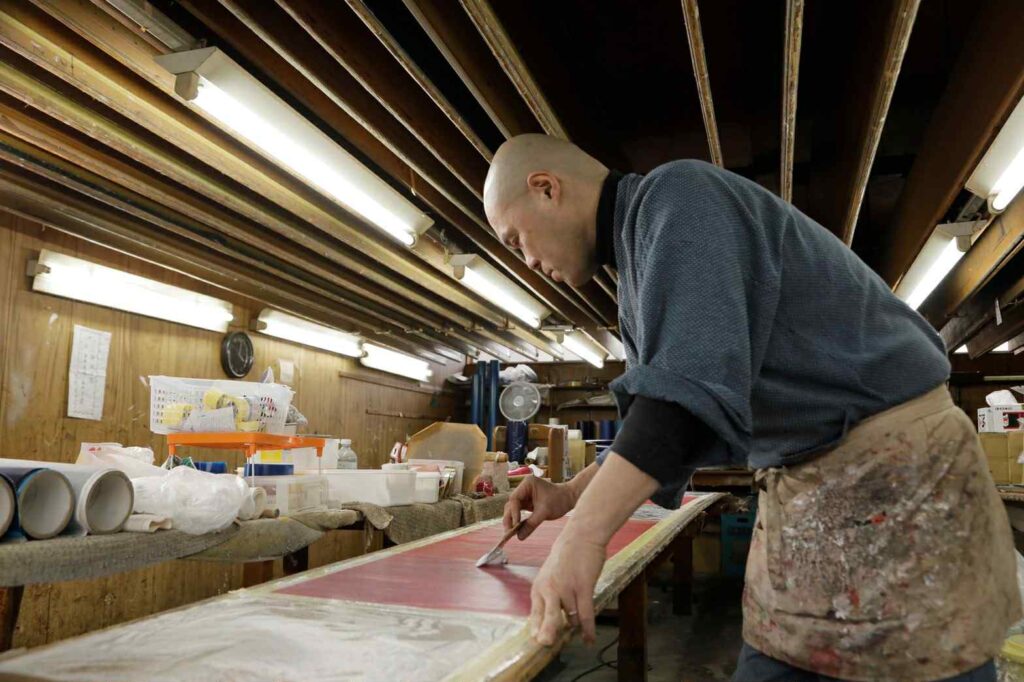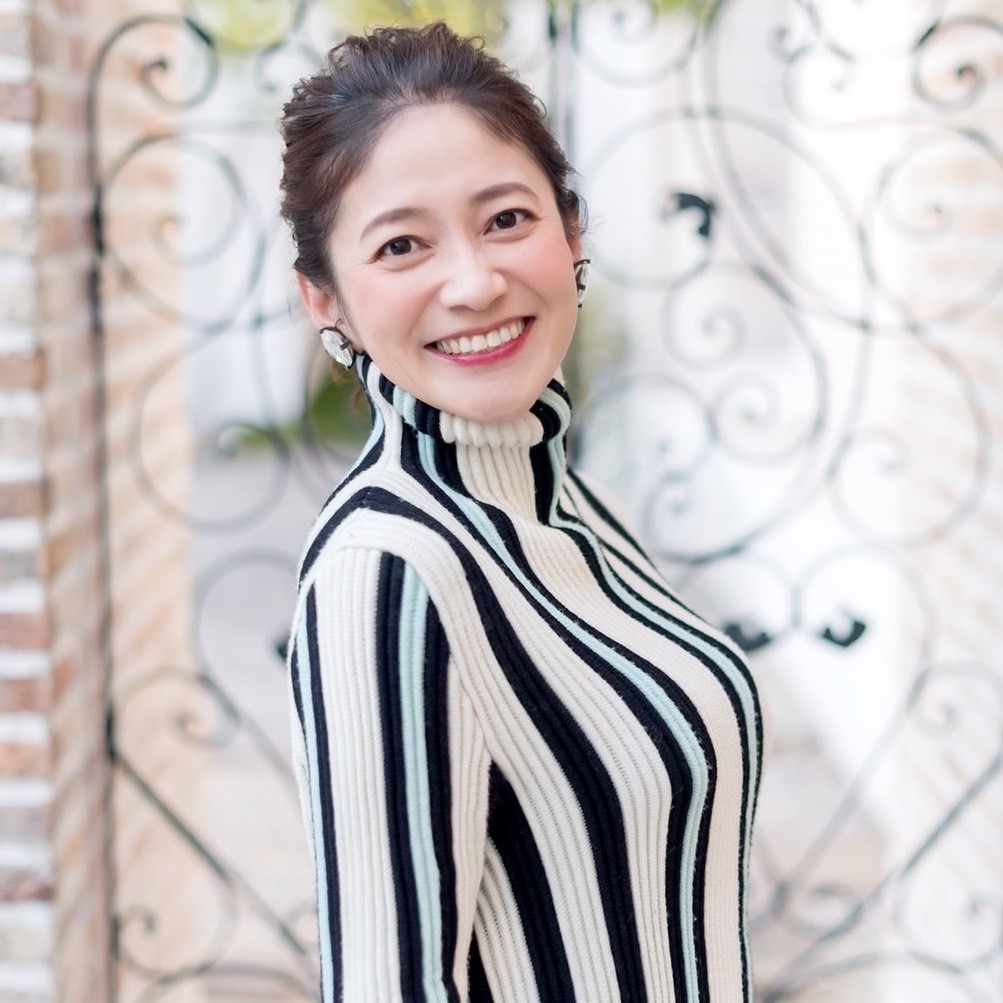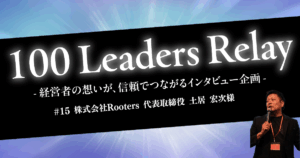🇯🇵日本語
「働くことは、人生の喜びそのもの。」
そう静かに語るのは、京都・太秦に工房を構える職人、三宅誠己さん。
伝統と革新の狭間で、“やめない覚悟”を胸に、
打掛からインテリア、アートピースまでを自らの手で生み出している。
「手仕事を続ける限り、技術は生き続ける。だから私はやめないんです。」
🔹 伝統を背負い、工程を再設計する
三宅さんが率いる工房では、花嫁のための打掛をすべて自社で制作。
花嫁個人や全国のウェディングプランナーへ直接レンタル提供している。
もう一つの柱は、伝統技術を活かしたインテリアやアクセサリーなど、
“暮らしに寄り添う工芸”の創出だ。
本来、着物づくりは20以上の分業工程で成り立つ。
しかし職人の高齢化と後継者不足により、名人の引退とともに工程ごと消滅してしまう現実がある。
「だからこそ、染めから仕立てまでを工房内で一気通貫にしました。
ただ集約するのではなく、“同じ結果を別の方法で再現する”。
その置き換えを何十と重ね、いまでは“どう作っているのかわからない”と言われるほどになりました。」
分業の崩壊を嘆くのではなく、時代に合わせて工程を再設計する──
その挑戦こそが、三宅工房の最大の強みだ。

🔹 「継ぐ」と決めたのは、大学受験の直前
両親は和装職人。
幼い頃から家の中には反物や染料の匂いがあったが、
早くから“職人になる”と決めていたわけではない。
ピアノや絵画、ラグビー、バンド活動──
表現と身体性の狭間で模索する少年時代を送った。
「腹を決めたのは高校卒業の直前。
四年制大学の受験勉強をしながら、“自分の手で作る道”を選びました。」
いまも往復1時間を徒歩通勤し、イヤホンで音楽を聴きながら頭と心を整える。
「室内作業が多いから、歩く時間がリセットタイム。
音楽は“仕事に入るスイッチ”なんです。」
🔹 “貝を布に貼る”という無謀──20年越しの螺鈿
彼の代表作を見れば一目瞭然だ。
光の角度で静かに輝くアワビの貝殻──螺鈿が、打掛の布地に散りばめられている。
しかし本来、螺鈿は硬い素材を漆に貼り込む技法。
柔らかな布に施し、さらに着用に耐える強度を持たせることは「あり得ない」と言われてきた。
「最初は一度座るだけで割れました。
でも、“できません”は言わないと決めたんです。
20年以上かけて、素材の柔軟化、接着、下地、縫製──
全部を作り替えました。今では意図的に剥がそうとしても取れません。」
この技術を応用した螺鈿Tシャツは、家庭の洗濯機で洗える。
「“洗えないのが常識”の装飾に、実用レベルを通す。
着られる工芸にするのが自分の仕事です。」

🔹 「できません」を封印した日が、技術を産んだ
転機は、無茶な注文を受けたときだった。
「“魔法みたいな加工をしてくれ”と言われたんです。
断れば終わり。でも、やるしかないと思った。
やり切る。その繰り返しが、やがて世界にない技術に変わっていきました。」
その姿勢は、妥協のない品質意識と表裏一体だ。
「美しく作るだけでは足りません。
花嫁が安心して纏えるところまで詰めるのが職人の責任です。」
🔹 京都・太秦で“必ず成功する”体験を
工房は京都・太秦(嵐山から車で約15分/映画村から約5分)。
家族3人(本人・妻・次男)で営み、見学やワークショップも行う。
国内外からの来訪者が後を絶たない。
「大切にしているのは、“必ず成功するものづくり体験”。
苦手な人でも“できた!”で終われる設計にしています。
成功体験は、ものづくりの喜びに変わるんです。」
🔹 後継者に要るのは、センスより「やめない覚悟」
次世代は26歳の次男が中心。今後は人も増やす予定だ。
ただし、条件はただ一つ。
「絶対にやめない人。全部できなくていい。
一部門が得意でもいい。AIを使って発想のヒントを得てもいい。
でも、最後は“手で作る”こと。そして、やめない覚悟だけは必須です。」
🔹 会社は“もう一人の人”──だから潰さない
数年前、主力取引先の倒産で工房は大きな打撃を受けた。
それでも、三宅さんの軸は揺れなかった。
「法人は“法律の人”。会社を潰すのは人を殺すのと同じです。
どんな会社にも試される瞬間は来る。
そこで諦めないことが、経営者の資質だと思います。」
その支えとなるのが、「すべての出来事に意味がある」という哲学。
「受け止め方が変われば、未来が変わる。
苦い経験も、自分を鍛える材料になるんです。」
🔹 京都から世界へ──“作る場所”は日本に
5年後、10年後のビジョンも明快だ。
「“日本の職人=三宅”と世界で顔が浮かぶ存在になること。
海外にはギャラリーや拠点を置きますが、作るのは日本。
京都に生まれた意味を信じて、中心はここに置きます。」
🔹 小さな“寺子屋”の夢──成功体験を配る
未来へのもう一つの夢は、「できた!」を広げる小さな寺子屋。
「小学生でも大人でも、誰でも成功体験を得られる設計にしたい。
“苦手”を“できた”に変える瞬間が、人を動かします。
分野を超えて、志を同じくする仲間たちとオンラインの寺子屋をつくりたい。」
🔹 “働けること”が、いちばんの幸せ──映画のタイトルは『働きは最上の喜び』
学びの場や人との出会いを通して、自らの在り方を磨き続けている。
「仕事がなく、何もできなかった時期もありました。
でもその経験があったからこそ、今は“働ける”ことに感謝できる。
これからも、働き続ける人生を楽しみたい。
120歳まで現役のつもりです。」

🇺🇸英語
“Work Is the Greatest Joy” — The Kyoto Artisan Who Turns Perseverance Into Art
Interview with NOB MIYAKE
“Work itself is the joy of life.”
So says Nob Miyake, an artisan based in Uzumasa, Kyoto, who continues to create bridal kimono, interior art, and wearable craft pieces entirely by hand.
Balancing tradition and innovation, he carries a quiet conviction:
“As long as I keep working with my hands, the technique will live on. That’s why I will never stop.”
🔹 Redesigning Tradition, One Process at a Time
At his Kyoto atelier, Miyake produces every bridal kimono—from dyeing to finishing—within his own workshop.
In addition to offering direct rentals to brides and wedding planners nationwide, he also creates interior and art pieces that bring traditional craftsmanship into modern living.
Traditionally, kimono-making involves more than 20 specialized artisans, each responsible for a separate step.
But with aging craftsmen and a lack of successors, entire techniques have begun to vanish.
“So I decided to take everything in-house—from dyeing to sewing. But it’s not just about combining processes. I’ve spent years finding different methods to achieve the same result. Some experts even say, ‘We can’t tell how you made this.’”
Rather than lamenting the decline of division-based craftsmanship, Miyake has redesigned the entire production process to fit modern times—a reinvention that has become the atelier’s greatest strength.
🔹 The Decision to Inherit Came Just Before College
Both of Miyake’s parents were kimono artisans, and he grew up surrounded by fabrics and dye.
Yet he never assumed he would follow in their footsteps.
As a child, he studied piano and painting; in high school, he played rugby and joined a band—always drawn to expression and physicality.
“I made up my mind just before graduating. While preparing for university exams, I decided to choose the path of making things with my own hands.”
Even today, he walks an hour to and from his atelier, using the time to clear his mind while listening to music.
“Because I spend so much time indoors, that walk resets me. Music is the switch that gets me ready to work.”
🔹 The “Impossible” Dream of Shell Inlay — 20 Years of Mother-of-Pearl
Look closely at Miyake’s kimono and you’ll notice a soft shimmer:
the iridescent glow of mother-of-pearl (raden), traditionally used in lacquerware, not textiles.
Attaching hard shell fragments to soft fabric strong enough for wear seemed impossible.
“At first, the shells cracked as soon as someone sat down,” he recalls.
“But I made a promise to myself never to say, ‘It can’t be done.’
It took over 20 years of rethinking everything—softening materials, changing adhesives, layering techniques, and altering stitching.
Now, you can’t even peel them off intentionally.”
The same innovation led to a washable mother-of-pearl T-shirt, durable enough for a household washing machine.
“My mission is to take what was once only decorative and make it wearable craftsmanship.”


🔹 The Day “Impossible” Was Banned From His Vocabulary
A major turning point came with an impossible client request.
“They told me to create something that looked like magic,” Miyake laughs.
“I realized if I refused, it would end there. So I took it on—and that cycle of trying and creating became a technology found nowhere else in the world.”
That philosophy is paired with a deep sense of responsibility.
“Beauty alone isn’t enough. My duty is to ensure the bride can wear it with complete confidence. That’s the craftsman’s responsibility.”
🔹 A Workshop in Uzumasa Where Everyone Succeeds
Located about 15 minutes from Arashiyama and 5 minutes from the Kyoto Film Village,
Miyake’s atelier is run with his wife and their second son.
They welcome visitors for workshop tours and hands-on experiences, including international guests.
“What matters most is ensuring that everyone succeeds.
Even those who think they’re not good with their hands should leave saying, ‘I did it!’
That moment of success—that’s where the joy of making begins.”
🔹 For the Next Generation, What Matters Most Is “Never Quitting”
Miyake’s 26-year-old son now leads much of the production, and the atelier plans to expand.
But his hiring philosophy is simple.
“I only ask one thing: never quit.
You don’t have to master every skill—just one field is enough.
You can even use AI to get inspiration.
But in the end, it must be made by hand. Perseverance is non-negotiable.”
🔹 A Company Is a Living Being — That’s Why You Don’t Let It Die
A few years ago, the atelier suffered a heavy blow when a major client went bankrupt.
Even then, Miyake’s belief did not waver.
“A corporation is a legal person. To let a company die is like killing a human being.
Every company faces its test. The essence of leadership is to endure.”
His perspective is rooted in one conviction:
“When the way you see things changes, your future changes.
Even bitter experiences can become the material that strengthens you.”
🔹 From Kyoto to the World — Creation Belongs in Japan
Miyake’s vision for the next decade is crystal clear.
“I want people around the world to hear the name ‘Miyake’ and think, the Japanese artisan.
I may open galleries abroad, but everything will still be made in Japan.
I was born in Kyoto for a reason—and this will always be the center of my work.”
🔹 A “Terakoya” for the Future — Sharing the Joy of Making
Miyake dreams of creating a small terakoya (learning hub) where anyone—children or adults—
can experience the joy of making something with their own hands.
“I want to design workshops where success is guaranteed.
That ‘I did it!’ moment can change a person.
Together with like-minded creators, I’d love to build an online terakoya that spreads those moments across fields and generations.”
🔹 “To Work Is to Live” — His Film Title: Work Is the Greatest Joy
Through decades of craftsmanship and learning, Miyake has continued refining his way of life.
“There were times when I had no work at all.
But because of those experiences, I can now feel pure gratitude just for being able to work.
I want to keep enjoying this life of creation—
I plan to stay active until I’m 120.”

【PROFILE】
三宅 誠己(NOB MIYAKE)
三宅工芸株式会社代表取締役。京都・太秦に自社工房を構え、花嫁打掛の制作・レンタルを中心に、螺鈿をはじめとする工芸技術を現代に再構築。染めから仕立てまで一貫生産を行い、“着られる工芸”を世界へ発信している。伝統を継承しながらも革新を恐れず、「働きは最上の喜び」を信条に、120歳まで現役を掲げている。
NOB MIYAKE
CEO of NOB Co., Ltd., based in Uzumasa, Kyoto.
Specializes in handcrafted bridal kimono and wearable crafts that merge traditional techniques—such as raden (mother-of-pearl inlay)—with modern innovation.
By integrating all processes in-house, from dyeing to tailoring, he redefines what “craftsmanship” can be.
Guided by his belief that “Work is the greatest joy,” Miyake continues to create with unshakable dedication—and plans to remain active for life.

【PROFILE】
真綺(Maki)
語りの芸術家/インタビュアー/コミュニケーション・スペシャリスト
8年間“しつもん力”を教え、日本語と英語の間で人の想いを橋渡ししてきた。
これまで国内外で、経営者、アーティスト、国際的イベントの登壇者など延べ数千人と対話。
世界的な授賞式や王室叙任式のスピーチ・通訳も担当し、言葉と存在感の両面から人の魅力を引き出す。
Maki
Word Painter / Interviewer / Communication Specialist
For eight years, Maki has taught the art of asking powerful questions, bridging stories between Japanese and English.
She has engaged in thousands of conversations with business leaders, artists, and speakers at international events, both in Japan and abroad.
Her work includes speeches and interpretation for global award ceremonies and royal investitures, capturing and conveying the essence of a person through both words and presence.
経営者の存在感を、言葉とストーリーに刻む。
真綺による日英インタビューにご興味のある企業様はこちらからお問い合わせください。










コメント